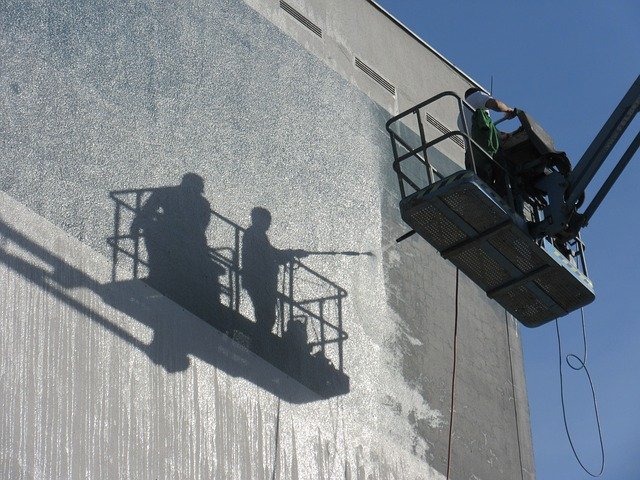Facade cleaning
Contents |
[edit] Introduction
In its broadest sense, the term ‘facade’ can refer to any predominantly vertical face of a building envelope, such as an external wall. Consequently, a building may have more than one facade, such as the north facade, south facade and so on. Terraced buildings may only have two facades - a front facade and a rear facade.
Sometimes the term ‘facade’ is used to refer more specifically to external faces of buildings that have particular architectural emphasis, such as an imposing design, decoration, the main entrance to the building and so on. This will typically be the front of the building, facing onto a street or other public open space, but it may also be other faces depending on their architectural treatment and importance.
[edit] Why clean facades
Building facades should be cleared of pollutants, grime, stains and unsightly marks on a regular basis. A clean facade can not only have a positive impact on public impression, it can also help attract or retain tenants and make a positive contribution to the surrounding neighbourhood.
Regular facade cleaning may reveal areas of the structure that have been affected by - or are vulnerable to - other types of problems. For instance, removing a seedling during the cleaning process can serve as a proactive measure that will prevent invasive root growth that could damage the facade (or even contribute to some form of structural failure). Removing dirt and stains may also reveal other structural vulnerabilities. Identifying these problems in their early stages may help building owners avoid more significant problems in the future.
[edit] How to clean facades
Generally, facade cleaning methods are water based. This conservative approach to removing typical dirt and grime includes pressure washing, soaking, and steam heat washing. However, in some instances, methods may include chemical treatments, sand blasting and so on and may involve scaffolding, protective sheeting and so on.
Building facades are made from different materials, such as stone, wood, glass, aluminium, stainless steel and so on. The type of material will dictate the cleaning method as will the building’s location (which influences weather related facade degradation). The building’s function may also be a factor.
[edit] Stone
While stone may appear invulnerable in its natural form, when incorporated into a building facade its appearance can become significantly compromised by both natural and chemical pollutants. Cleaning stone facades can require special knowledge, since incorrect methods can cause irreparable damage.
Ideally, stone facades should be cleared in advance of any dirt that builds up. This means special attention should be paid to damp areas on the stone. Simple cleaning solutions can include vinegar, dish soap and warm water. Tools can include a sponge, soft brush or rotary tool fixed with a buffing device.
[edit] Timber
Timber facades should be cleared of any natural growth (such as moss or algae) that has accumulated. It can then generally be cleaned with a simple solution of dish soap and warm water. Tools can include a sponge and soft brush to apply the solution, which is then rinsed with clean water.
[edit] When to clean facades
Cleaning a facade should be part of a larger maintenance programme. It should also be part of the early investigation process before any facade repairs take place. A clear facade, free of dirt, stains or other unwanted materials will provide a better surface for restoration work and will make problems easier to identify.
[edit] Who should clean facades?
In some situations, small scale facade cleaning can be undertaken by facilities and maintenance staff. This will require the proper skills and equipment, particularly when working at height. For larger facade cleaning projects, it may be necessary to hire an expert who has both the knowledge and equipment - such as pressure washers and scaffolding - to do the job safely and effectively.
[edit] Related articles on Designing Buildings Wiki
Featured articles and news
Architects, architecture, buildings, and inspiration in film
The close ties between makers and the movies, with our long list of suggested viewing.
SELECT three-point plan for action issued to MSPs
Call for Scottish regulation, green skills and recognition of electrotechnical industry as part of a manifesto for Scottish Parliamentary elections.
UCEM becomes the University of the Built Environment
Major milestone in its 106-year history, follows recent merger with London School of Architecture (LSE).
Professional practical experience for Architects in training
The long process to transform the nature of education and professional practical experience in the Architecture profession following recent reports.
A people-first approach to retrofit
Moving away from the destructive paradigm of fabric-first.
International Electrician Day, 10 June 2025
Celebrating the role of electrical engineers from André-Marie Amperè, today and for the future.
New guide for clients launched at Houses of Parliament
'There has never been a more important time for clients to step up and ...ask the right questions'
The impact of recycled slate tiles
Innovation across the decades.
EPC changes for existing buildings
Changes and their context as the new RdSAP methodology comes into use from 15 June.
Skills England publishes Sector skills needs assessments
Priority areas relating to the built environment highlighted and described in brief.
BSRIA HVAC Market Watch - May 2025 Edition
Heat Pump Market Outlook: Policy, Performance & Refrigerant Trends for 2025–2028.
Committing to EDI in construction with CIOB
Built Environment professional bodies deepen commitment to EDI with two new signatories: CIAT and CICES.
Government Grenfell progress report at a glance
Line by line recomendation overview, with links to more details.
An engaging and lively review of his professional life.
Sustainable heating for listed buildings
A problem that needs to be approached intelligently.
50th Golden anniversary ECA Edmundson apprentice award
Deadline for entries has been extended to Friday 27 June, so don't miss out!
CIAT at the London Festival of Architecture
Designing for Everyone: Breaking Barriers in Inclusive Architecture.
Mixed reactions to apprenticeship and skills reform 2025
A 'welcome shift' for some and a 'backwards step' for others.

























